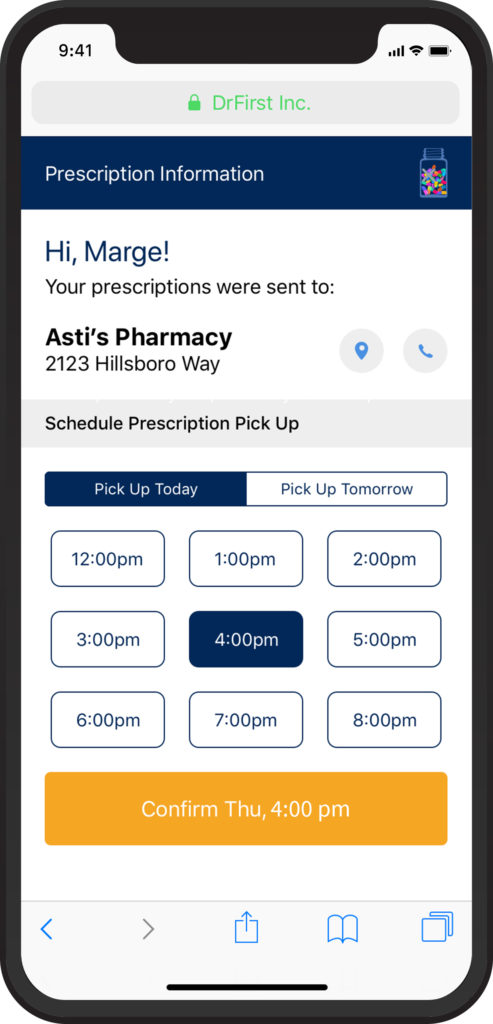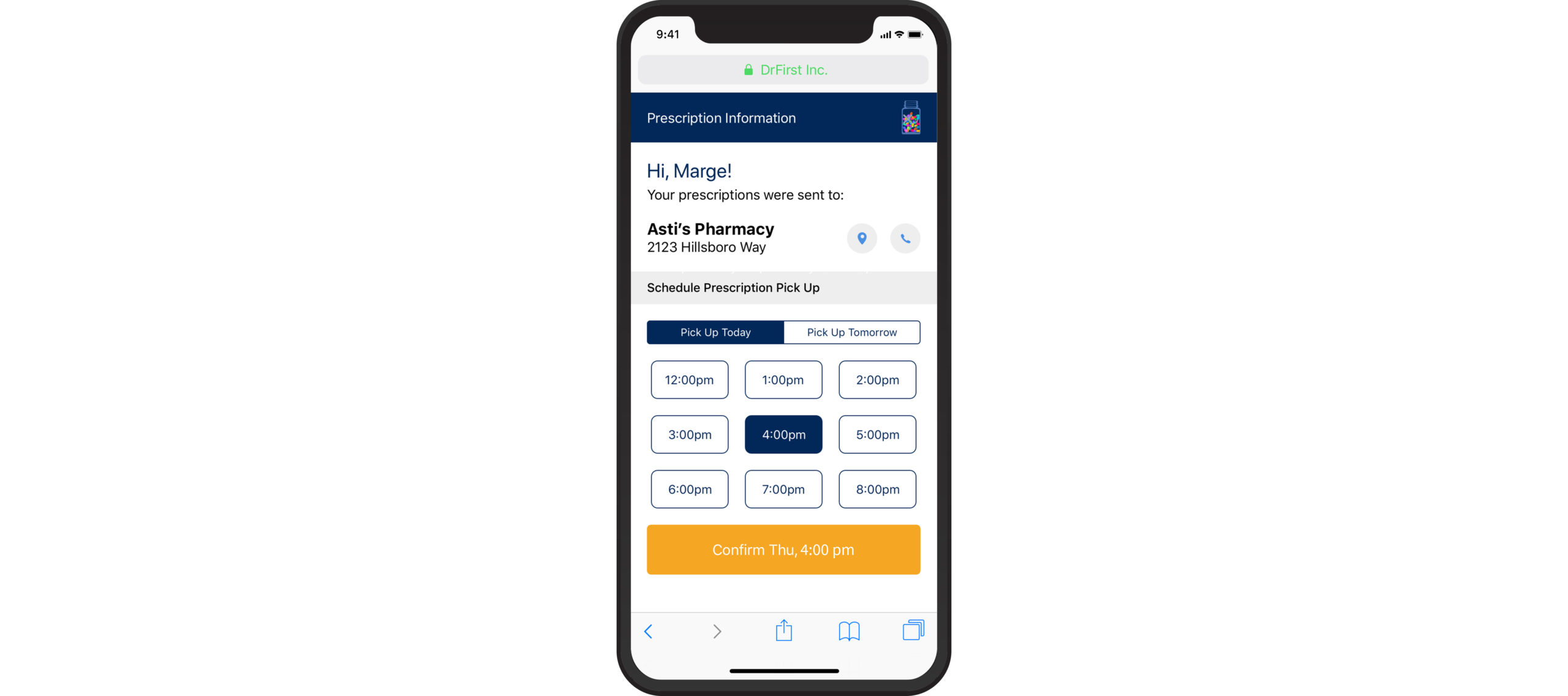Pharma’s adherence problem often starts before a patient even fills the prescription for the first time. This “first fill” problem has been examined by many over the years including by Harvard Medical School in 2010 when they found 24% of first-time patient prescriptions were never filled by analyzing e-prescription data for over 75,000 patients. In 2017, IQVIA Institute for Human Data Science looked at the impact of cost on first fill abandonment and found that 69% of commercially insured patients did not fill their new prescriptions when they had to pay more than $250 out of pocket compared to just 11% who had an out-of-pocket cost of less than $30. And in 2013, Kaiser Permanente found that 29.5% of women who were prescribed a new bisphosphonate medication failed to pick up their prescription based on the electronic health records (EHR) of 8,454 women ages 55 and over.
DrFirst, a leading provider of e-prescribing and medication management solutions, has been working on a solution, informally called Link, that is able to increase first fill prescriptions by a baseline of 11%. While DrFirst’s solutions have traditionally been geared toward physicians, IDNs, payers, and EHR vendors, they are now taking the technology and features that allow them to track e-prescriptions, determine cost to patients, and more, and directing them to patients.
“About two and a half years ago, we realized that the tools we’re giving to providers could potentially deliver even greater value to patients by making them available in a personalized, real-time, and relevant manner,” says Luis Angel, President of DrFirst’s Consumer Solutions division. “By working in collaboration with our partners, we rolled out a solution that engages the patient but is delivered on behalf of their provider, in support of the prescribed therapy, which is extremely important.”
 Patients receive an automatic notification from their providers which gives them access to a personalized toolset providing details on the drugs prescribed, copay pricing, and pharmacy location and contact information. The intent is to alleviate some of the anxiety and confusion patients may experience regarding the cost and necessity of filling their prescriptions.
Patients receive an automatic notification from their providers which gives them access to a personalized toolset providing details on the drugs prescribed, copay pricing, and pharmacy location and contact information. The intent is to alleviate some of the anxiety and confusion patients may experience regarding the cost and necessity of filling their prescriptions.
“Over the last two years, we’ve added the magic,” Angel explains. “And the magic is really made up of delivering the tools we already had in a form accessible to patients. We’re helping them overcome the three main barriers that are the underlying causes of the abandonment problem.”
Alleviating Prescription Abandonment
In addition to just providing basic information, the solution can now be tailored to address three other areas that typically impact whether a patient fills their prescription:
- Clinical Concerns: DrFirst provides education that explains to the patient what the medication is called, how to pronounce it, what it’s for, side effects, how to be cautious about starting this new treatment, etc. Currently, the company is able to deliver education for nearly all prescriptions available in the United States.
- Procrastination/Forgetfulness: Patients can schedule the pickup of their medication to ensure it is ready when they arrive, which drives commitment and increases the likelihood that they’re going to show up at the pharmacy.
- Financial Obstacles: The solution offers pricing transparency by revealing the copay the patient will have to pay for the prescription. But it will also help address any financial barriers by providing information on potential copay assistance programs.
So far, about 60% of the patients who are sent a notification, engage within an hour of visiting the doctor. But even those who don’t engage are also more likely to fill their prescription.
“The more engagement patients have with the solution—the more they click through, use the tools that are available, look at the coupons, and things like that—then the higher the fill rate,” says Paul Rabideau, PhD, Senior Advisor at KMK Consulting Inc., which has examined the effectiveness of the Link solution. “So, there is an 11% increase simply because Link has been provided—even if they don’t click through—because they’ve gotten a reminder. But we’ve seen another 20% increase in fill rate when they engage fully.”
To study the effectiveness of Link, KMK Consulting examined DrFirst records related to about 35 million patients, including both notifications and fill records. KMK Consulting was able to compare the fill rates of the patients exposed to Link versus those who were not.
In addition to a higher fill rate for those who engage with Link versus those who just receive it but don’t click, Angel says they have also seen results vary based on demographics as well as therapeutic class. Fill rates have increased by as much as 20% to 35% for certain therapeutic classes, and they have also seen higher rates for patients in their 30s and 40s compared to older patients.
How Pharma Can Get Involved
Starting as a beta rollout in June 2016 to just a few hundred doctors, the solution is now widely available to DrFirst’s providers and vendor customers and its implementation is quickly growing. Angel estimates that in the last month they have seen utilization increase by 25% and they expect the number to double by the end of this quarter. One reason for the growth: Provider partners are encouraged by the 97% to 98% patient satisfaction ratings these notifications have received. And now DrFirst wants to also increase its partnerships with pharma companies to help make the library of educational content even more relevant and robust for patients.
DrFirst has already worked with dozens of brand teams who can offer customized educational content for the solution and reach patients in real-time who need access to patient assistance programs. Additionally, DrFirst can help pharma researchers with clinical trial recruitment by identifying appropriate patients for the study who are also in close proximity to where it is being conducted.
DrFirst and KMK Consulting perform A/B and C/B testing for pharma brand teams’ educational content so they can try different versions and discover which are the most effective and for whom. With about 1,000 data points every day in terms of ratings from patients, including about 40,000 reviews a month with qualitative feedback, the company is able to constantly tweak the platform to meet patients’ desires.
“My vision for this is that the experience of interacting with DrFirst will be different for every patient, because the content and materials will differ based on factors such as the therapeutic class, the specialty of your doctor, the frequency which you get prescriptions, and more,” Angel explains. “We’re looking at different factors and we’re moving into that next layer of personalization this year that we hope will make it even more appealing and more effective.”
Expanding on the Solution’s Capabilities
“We started with a very focused approach to solve abandonment and we are currently 100% focused on that,” Angel says. “But we already see in the very near term the opportunity to turn the page and expand our offering to let patients continue using some of the tools to help guide them along their treatment journey.”
For instance, Angel mentions the potential for the educational content to evolve with notifications and prompts along the treatment journey. While patients may initially start with a video explaining the medication, they could receive a prompt in two weeks that explains how to deal with side effects that they may be experiencing at that time. Another expansion could be the ability to set up automatic refill reminders for medications, to help keep patients on their therapy. They could also receive notifications about how to continue saving money on their therapy or other programs available that can make their experience while taking the medication more convenient.
“We’re all about medication management at DrFirst,” adds G. Cameron Deemer, President of DrFirst, “And we have the intelligence and information to help support patients through the entire scope of therapy, which goes beyond the first fill or the second fill, but throughout the entire process.”










